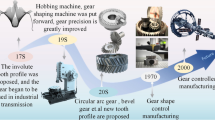Abstract
Face gear drives have been well applied in high-speed and heavy load applications. Due to the strict requirements of machining accuracy and quality for those applications, face gears are mainly manufactured by worm grinding method, of which a dressing wheel is applied to generate the worm surface as its enveloped surface. Based on this manufacturing process, the profile of the dressing wheel should be well defined to make sure the final meshing performance of the face gear drives. In this work, we firstly investigate the mathematical model of dressing wheel with a general profile modification. The worm surface is the envelope to the family of dressing wheel surfaces. Specially, the result is obtained as a closed-form. Subsequently, the face gear tooth surface is calculated as the envelope surface of the worm surface. With the tooth surface models of both face gear and pinion, the tooth contact analysis (TCA) can be computed. According to this method, different parameters for the profile modification of the dressing wheel are compared to improve the working performances by finding the minimal transmission error without edge contacts. The proposed method is validated with simulations.









Similar content being viewed by others
Abbreviations
- γ0 :
-
Initial installation angle of dressing wheel (Fig. 1)
- φg :
-
An instantaneous position angle of the dressing wheel relative to the worm (Fig. 1)
- φw :
- E g :
-
Shortest distance between two axes of the dressing wheel and the shaper (Figs. 1 and 2)
- E ws :
-
Shortest distance between two axes of the worm and the shaper (Figs. 1 and 6)
- θ:
-
Angle of rotation of the dressing wheel (Fig. 2)
- s 0 :
-
The tooth width of the standard rack cutter (Fig. 3)
- l d :
-
The length of oro0 (Fig. 3)
- α0 :
-
Pressure angle of the standard rack cutter (Fig. 3)
- f d :
-
The offset distance between p0 and o0 (Fig. 3)
- u r :
-
Rack cutter profile parameters (Fig. 3)
- a r :
-
Parabolic coefficient of the rack cutter profile (Fig. 3)
- p 0 :
-
The vertex of the parabola (Fig. 3)
- p r :
-
One point on the rack cutter profile (Fig. 3)
- N g :
-
Normal vector of a point on the surface of the dressing wheel (Fig. 4)
- T g :
-
Tangent vector of a point on the surface of the dressing wheel (Fig. 4)
- T gx :
-
The component of tg along the direction of xg (Fig. 4)
- T gz :
-
The component of tg along the direction of zg (Fig. 4)
- α:
-
The angle between tgx and tgz (Fig. 4)
- p :
-
One point on the dressing wheel (Fig. 4)
- p h :
-
The intersection of ng and zg (Fig. 4)
- h :
-
The distance between the points og and ph (Fig. 4)
- ρ:
-
The distance between the points p and ph (Fig. 4)
- φs :
-
Angle of rotation of the shaper (Fig. 6)
- φ2 :
-
Angle of rotation of the face gear (Fig. 6)
- E 2s :
-
The distance between the central points of face gear and shaper (Fig. 6)
- λw :
-
Crossing angle between axes of shaper and worm (Fig. 6)
References
Litvin FL, Fuentes A (2004) Gear Geometry and Applied Theory. Cambridge University Press, Cambridge, ISBN 978-0-5218-1517-8
Litvin FL, Wang JC, Bossler RB, Chen YJ, Heath G, Lewicki DG (1994) Application of facegear drives in helicopter transmissions. J Mech Des 116(3):672–676
Litvin FL, Egelja A, Tan J, Heath G (1998) Computerized design, generation and simulation of meshing of orthogonal offset face-gear drive with a spur involute pinion with localized bearing contact. Mech Mach Theory 33(1–2:87–102
Litvin FL, Hsiao CL (1994) Computerized Simulation of Generation of Internal Involute Gears and Their Assembly, Transactions of ASME. J Mech Des 116:683–689
Litvin FL et al (1996) Apparatus and method for precision grinding face gear. US-Patent 6.146.253. https://patentimages.storage.googleapis.com/a1/49/67/72737f55a7bdbe/US6146253.pdf
Litvin FL, Wang JC, Bossler RB et al (1994) Application of Face-Gear Drives in Helicopter Transmissions. J Mech Des 116(3):672
Litvin FL, Fuentes A, Zanzi C et al (2002) Face-gear drive with spur involute pinion: geometry, generation by a worm, stress analysis. Comput Methods Appl Mech Eng 191((25–26):2785–2813
Zhou Y, Tang J, Zhou H, Yin F (2016) Multistep Method for Grinding Face-Gear by Worm. J Manuf Sci Eng 138:71013–71018
Yang X, Tang J (2014) Research on manufacturing method of CNC plunge milling for spur face-gear. J Mater Process Tech 214:3013–3019
Tang J, Yang X (2016) Research on manufacturing method of planing for spur face-gear with 4‑axis CNC planer. Int J Adv Manuf Technol 82:847–858
Zhou Y, Wang S, Wang L, Tang J, Chen Z (2019) CNC milling of face gears with a novel geometric analysis. Mech Mach Theory 139:46–65
Zhou W, Tang J, Chen H, Shao W, Zhao B (2019) Modeling of tooth surface topography in continuous generating grinding based on measured topography of grinding worm. Mech Mach Theory 131:189–203
Wu Y, Zhou Y, Zhou Z et al (2018) An advanced cad/cae integration method for the generative design of face gears. Adv Eng Softw 126:90–99
Zhou Y, Wu Y, Wang L, Tang J, Ouyang H (2019) A new closed-form calculation of envelope surface for modeling face gears. Mech Mach Theory 137:211–226
Zhou Y, Chen Z (2015) A new geometric meshing theory for a closed-form vector representation of the face-milled generated gear tooth surface and its curvature analysis. Mech Mach Theory 83:91–108
Author information
Authors and Affiliations
Corresponding author
Rights and permissions
About this article
Cite this article
Shi, X., Zhou, Y., Zhang, W. et al. A new worm grinding method of face gears based on the optimization of dressing wheel profile. Forsch Ingenieurwes 83, 751–757 (2019). https://doi.org/10.1007/s10010-019-00353-6
Received:
Revised:
Accepted:
Published:
Issue Date:
DOI: https://doi.org/10.1007/s10010-019-00353-6




